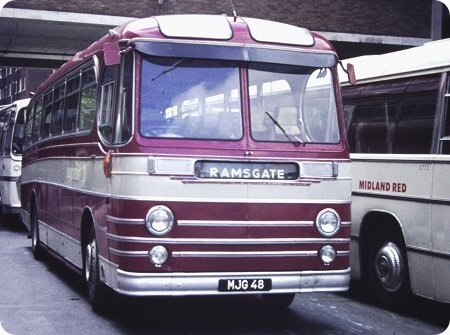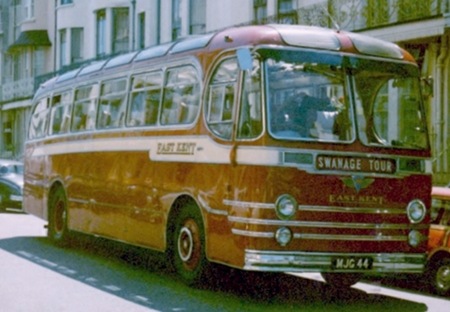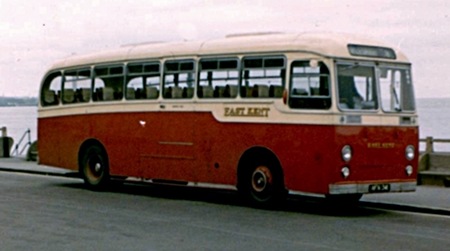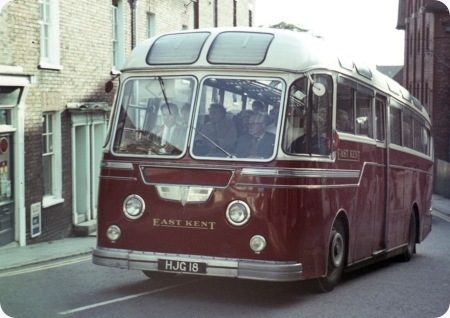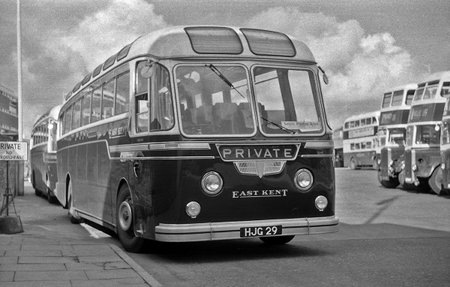East Kent – Dennis Lancet UF – HJG 3
East Kent Road Car Co Ltd
1954
Dennis Lancet UF
Duple C41C
This photo taken on Margate seafront in about 1966 shows HJG 3 numerically the first of a batch of 30 Dennis Lancet UF’s fitted with Duple Ambassador C41C bodies delivered to East Kent in 1954 these made up the largest fleet of Lancet UF’s in the country. Looking at this photo again recently I thought how the elegant simplicity of both the coachwork and the superb East Kent livery set one another off beautifully, on the Lancet the windscreens were set lower than on the contemporary Royal Tiger’s and Regal IV’s due to the Lancet’s lower driving position which also made the skylights above the screens more upright also the cab windows and the pillar behind the cab was a different shape.
I feel that the Lancet UF deserved more success than it achieved but obviously it did not appeal to those then all powerful figures the Fleet Engineers who didn’t like some aspects of the specification.
Photograph and Copy contributed by Diesel Dave
31/10/13 – 07:31
Rather like Leyland in the dark, dark days of British Leyland you feel in your guts that you ought to, that you want to like/support Dennis. Many the reputable operator ran Lances, Lancet(tte)s and, of course, Lolines. Glenton ran the last "batch" of Lancet UFs with Plaxton Panorama bodywork – another class act. Often, specifications were good – just quirky and unproven (not necessarily bad and unreliable). Fodens had this problem. I’m no great lover of the Javelin – I prefer heavyweights – but it was a solid workhorse in the style of Bedford and Ford. I did, however, take a Dennis R420 to the South of France one summer. With its ZF AStronic gearbox (and a bit of imagination!) you could call it a cheap GB Setra. Being very much a Setra man, I can say that the R420 was one of the best/nicest coaches I have ever driven. It never took off because it didn’t have Volvo Assist to back it up if it broke down. [My experience of Volvo Assist is that it wasn’t missing much.] So I can support Roger to the hilt. The R series should have been a success, it wasn’t Dennis’s fault it wasn’t – and I’m sure the same was true of the Lancet UF.
David Oldfield
31/10/13 – 15:52
Newport Corporation ran some Lancet UFs but most were bodied as coaches, weren’t they?
Geoff Kerr
01/11/13 – 08:18
Newport Corporation took 12 Lancet UF in two batches. In his book "Dennis Buses in Camera" Robin Hannay says that the first 4 had bus bodies but makes no comment about the second batch although in the picture it appears that they have bus seating. All bodies were built by D J Davies a local coach operator and Dennis agent.
Paragon
01/11/13 – 08:20
I have always admired these East Kent Lancet UF coaches. East Kent took a total of thirty of these machines, the biggest single order that Dennis received for the Lancet UF. Registered HGF 2 to 32, they all had the stylish Duple Ambassador IV bodywork, the first six being C32C and the remainder C41C. The low driving position of the Lancet UF was incorporated very successfully into the design, and the result was a classic to my eye. East Kent were dedicated Dennis users in the pre and early post WW2 period, and my very first experience as a small boy of the Guildford marque came about in 1947-49 with rides on the Lancet II buses, with their distinctive O4 engines, between Faversham and Herne Bay. Until the advent of the Dart and its derivatives, the vertical engined Lancet was Dennis’s most successful passenger type, and the firm must have hoped that the underfloor engined model would have captured at least some of the market. In fact, the total production of the Lancet UF came to 71, the last being delivered to Glenton Tours in 1961. Several reasons may be offered for this, but reliability was certainly not a factor. East Kent, for example, kept their Lancet UFs for around 17 years. Some of the problems lay with the Dennis design which included features that some bus company engineers viewed with caution. These included the low driving position (the ultimate industry acceptance of which Dennis anticipated by about twenty years) and the high pressure hydraulic braking system that, London Transport’s Routemaster excepted, never became popular. The Dennis ‘O’ type gearbox was an idiosyncratic affair that had sliding mesh (i.e true crash rather than constant mesh) engagement of the four lower gears, fourth being direct drive. To add to the fun, the gearstick operated the "wrong way round", upwards from right to left. Fifth gear was an overdrive with preselective engagement/disengagement using Maybach design principles. To engage fifth, the gear lever was pushed at any time from fourth position to the left and forward, but nothing happened until the accelerator and clutch were released to allow the revs to die. Then, releasing the clutch and applying the throttle would find the overdrive engaged. To disengage fifth, the stick would be moved back into fourth position at any time, and to actuate the system, the clutch had to be dipped and the engine blipped to raise the revs. Releasing the clutch pedal again would find fourth gear engaged. In the front engined Lancet, the proximity of the engine and gearbox to the driver allowed clean gear changes to be made by ear. In the UF, the remote location of the gearbox halfway down the chassis made this rather more difficult. Later models of the Lancet UF had the 8 litre rather than the 7.58 litre version of the O6 engine and a Meadows gearbox. When UF production finally finished, so did the manufacture of the O6, the last engine in the Dennis range to be offered. Thereafter, the firm used proprietary units. In the mid 1950s the BET group concentrated its purchasing upon AEC and Leyland products, and most other manufacturers of entirely acceptable machinery, including Dennis, were excluded from the ‘approved list’. Dennis tried again to enter the underfloor bus/coach market with the Pelican in 1956, which had the Dennis 92 bhp 5.5 litre engine and a conventional Meadows five speed constant mesh gearbox. The prototype made many demonstration tours, but the supremacy of AEC and Leyland in declining market conditions deterred the Guildford company from putting the Pelican into production. Yet again, however, the reliability of this unique machine was unquestionable. It ran for many years, first with Yellow Bus of Guildford, and finally with Chiltern Queens of Woodcote. More about the characteristics of the Lancet UF may be found on this site:- www.dennissociety.org.uk/nl/lancetuf.html
Roger Cox
01/11/13 – 14:02
Paragon – thanks, I meant to say "most others", i.e. other than Newport’s. I know there’s a preserved Brutonian vehicle and Aldershot & District had at least one with a bus body.
Geoff Kerr
01/11/13 – 17:57
As has been stated elsewhere on this site, Dennis Lancet UF KOT 600 was never owned by Aldershot and District. The confusion arises because the vehicle was painted in A&D livery and given the fleet number 187, but it remained the property of the manufacturer. It was operated on hire from Dennis from 1st February to 30 November 1953, after which it was returned to the Guildford factory. It subsequently went to Simmonds of Great Gonerby, near Grantham, and then to Cullings of Norwich who eventually passed it on to Blue Bus of Slough. At some stage in its life its Strachans B41R body was rebuilt with a front entrance. Aldershot and District went over to the AEC Reliance for its single deck requirements.
Roger Cox
03/11/13 – 09:02
"Somerset’s Buses" by Laurie James (Tempus 2004) is the source of much useful information concerning the Lancet UFs belonging to Hutchings and Cornelius of which the Brutonian example mentioned above is one. H&C were Dennis users for many years and in 1957 took 3 UFs YYB 117/8/9.117 was DP40F and the other 2 were B42F. All had full service lives. 118 ended up with Brutonian but the interesting thing is that 119 is shown as passing to a Preservation Group in Guildford in September 1973. Where is it now?
Paragon
10/11/13 – 17:17
I had a close relationship with the East Kent UFs when they were used on contract services at Dover Eastern Docks providing a road link from ships and hovercraft to Dover Priory railway station in the 1969 -1971 period. I can vouch for what Roger Cox says about the potential difficulties posed by the remote gearbox, the long linkages and the unconventional gate. I can remember even experienced drivers stirring the long gear lever to find what they were looking for. In spite of being in their late teens at the end at the time they presented a modern image alongside the new hovercraft, and dare I say it they were more reliable than an SRN4! Just worth noting that the East Kent fleet was HJG 3 – HJG 32, slightly different from the numbers in Roger’s comment.
Mike Harvey
11/11/13 – 15:14
Roger – When I was young, about four times a year, I’d get an A&D Lance from Woking to St. Peter’s Hospital, near Chertsey and would try and sit in the nearside/offside downstairs front seat and observe the driver. It was quite some time before I worked out how that Dennis ‘O’ gearbox worked and the strange ‘U’ movement by the driver, with no change in engine note at that moment. I was quite used to preselective methods with the LTE Daimlers around Morden, but a crash gearbox with pre-selective overdrive; egad; that was quite another thing! That whole area was also interesting in that you would have London Country and A&D buses popping in and out of turnings all over. Interesting times.
Chris Hebbron
14/11/13 – 06:00
Paragon enquires what became of YYB 119 once listed as preserved? A previous owner of now preserved YYB 118 told me that circa 1984 he had located 119 laid up behind a pub in the Guildford area. Photographs show that it was in fairly poor order, blocked up with a missing front wheel and a large pile of scaffolding stacked against one side. Despite enquiries no one could be found who knew anything about it and when he returned at a later date it had gone. And as far as I am aware, it has never been seen since. Attemps to trace members of "The Guildford LU2 Group" have been equally negative.
Nick Webster
15/11/13 – 06:25
Chris, the Lance K3 was a remarkable machine, with its free running 7.58 litre 24 valve O6 engine, giving (unlike the optimistic claims of contemporary Crossley and Daimler engines, both of which had a litre greater capacity) a genuine 100 bhp, and this was coupled to the ‘O’ type gearbox with its preselective overdrive fifth gear. It was probably the fastest double decker of its time. In an age when the legal maximum speed for a psv was 30 mph, it always amused me to read the plate on the internal cab bonnet side of the Aldershot and District Lances and Lancets – "Do not engage fifth gear below 30 mph". In my own experience, sadly only as a passenger, the drivers certainly complied, and these machines spent much of their time in overdrive. To the best of my knowledge, the A&D timetables of the 1960s did not differ greatly in terms of running time from those of the late 1950s. One had to drive a Loline pretty hard to get to Petersfield on time from Guildford or Aldershot, so the old 30mph limit must have been regularly observed in the breach.
Roger Cox
16/11/13 – 11:30
About,1963 I took a return journey from Portsmouth to Milford, swapping from Southdown to A&D at Petersfield.
The Southdown, from memory, was one of the East Lancs PD2/12 registration RUF ###’s, but the A&D was a Loline; interesting, but not a Lance, to my eternal regret Roger, on that challenging route.
Chris Hebbron
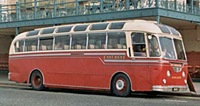 Vehicle reminder shot for this posting
Vehicle reminder shot for this posting
28/07/18 – 06:29
It’s confession time – I was the "Guildford LU2 Group" After my initial attempt at vehicle preservation (OWB GCV 623) failed with the vehicle being vandalised on a farm in Elstead, I tried again with YYB 119 which I bought directly from H & C and drove home. Sadly, after securing a parking space next to a pub in Witley, I tried to get an MOT and needed to replace the kingpins, something which I was unable to do. Having run out of money and enthusiasm, I am ashamed to say that the bus was abandoned and I suspect that the kindly publican probably sold it for scrap. My next foray into bus ownership was the purchase of VCH 172 from Tillingbourne which I operated as KRC Coaches (Later to become Surreyways).
Hans Retallick
Quick links to the - Comments Page - Contact Page - Home Page

